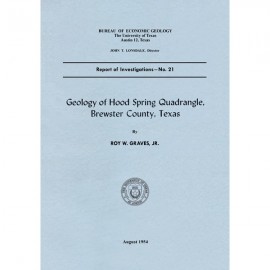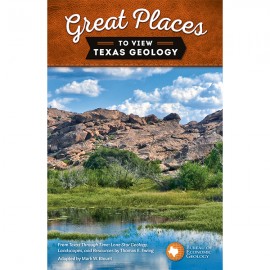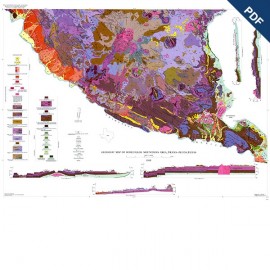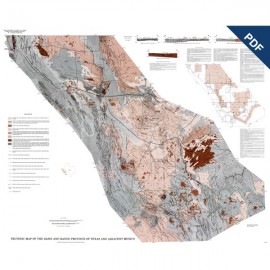Reports of Investigations
-
Books & Reports
- Reports of Investigations
- Guidebooks
- Udden Series
- Geological Circulars
- Down To Earth
- Atlases of Major Oil and Gas Reservoirs
- Texas Memorial Museum Publications
- Environmental Geologic Atlas of the Texas Coastal Zone
- Mineral Resource Circulars
- Other Reports
- Seminars and Workshops
- Handbooks
- Submerged Lands of Texas
- Symposia
- Annual Reports
- Open File Reports
-
Maps & Cross Sections
- Thematic Maps
- Miscellaneous Maps, Charts & Sections
- Geologic Atlas of Texas
- STATEMAP Project Maps
- Geologic Quadrangle Maps
- Cross Sections
- Highway Geology Map
- Energy and Mineral Resource Maps
- Shoreline Change and Other Posters
- Wilcox Group, East Texas, Geological / Hydrological Folios
- Bouguer Gravity Atlas of Texas
- River Basin Regional Studies
- Featured Maps
- Posters
- Teachers & the Public
-
Geological Society Publications
- Gulf Coast Association of Geological Societies
- Alabama Geological Society
- Austin Geological Society
- Corpus Christi Geological Society
- Houston Geological Society
- Lafayette Geological Society
- Mississippi Geological Society
- New Orleans Geological Society
- South Texas Geological Society
- GCS SEPM Publications
- Historic BEG & UT Series
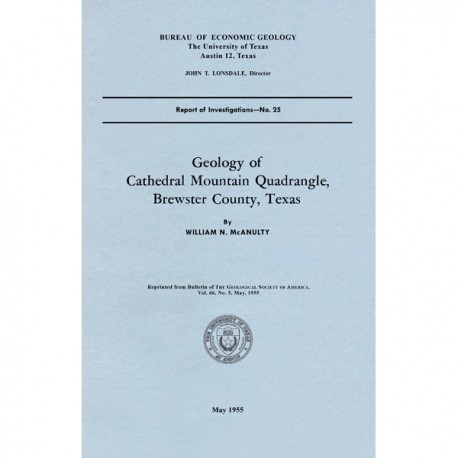
Geology of Cathedral Mountain Quadrangle, Brewster County, Texas
RI0025
Geology of Cathedral Mountain Quadrangle, Brewster County, Texas, by W. N. McAnulty, Sr. 48 p., 3 figs., 1 map, 2 pls. Reprinted from Geological Society of America Bulletin, v. 66, no. 5, 1955. Print
A free, digital version of this publication can be found on: Texas ScholarWorks
http://begstore.beg.utexas.edu/store/reports-of-investigations/2540-ri0025d.htmlRI0025. Geology of Cathedral Mountain Quadrangle, Brewster County, Texas, by W. N. McAnulty, Sr. 48 p., 3 figs., 1 map, 2 pls. Reprinted from Geological Society of America Bulletin, v. 66, no. 5, 1955.
To purchase a copy of the map only, please order MM0003.
ABSTRACT
Rocks exposed in the Cathedral Mountain quadrangle in the southeastern DavisMountains of Trans-Pecos Texas are assigned to the Word formation and to Capitan limestone in the Permian Guadalupe series; to the Maxon sandstone, Edwards limestone, Georgetown limestone, and Grayson (Del Rio) marl in the Cretaceous Comanche series; to the Buda limestone and Boquillas limestone in the Cretaceous Gulf series; and to the Buck Hill volcanic series in the Tertiary. Volcanic rocks up to 4600 feet thick cover most of the quadrangle. The volcanic succession, similar to that in Buck Hill and other quadrangles to the south, is divided into the Pruett tuff, Crossen trachyte, Sheep Canyon basalt, Potato Hill andesite, Cottonwood Spring basalt, Duff formation, and Rawls basalt. Vertebrate fossils indicate a late Eocene (Duchesne) age for the Pruett tuff (restricted to the lowermost tuff, sandstone, and conglomerate beds). The top of the Eocene is placed at a prominent disconformity between the Crossen trachyte and the Sheep Canyon basalt; it is suggested the overlying lava and tuff layers are Oligocene and younger (?). Some of the many intrusive bodies of alkalic microsyenite which are younger than the volcanic rocks have effected much local deformation of the layered rocks. Quaternary alluvium is present along streams and over valley flats.
Northward across the quadrangle, the Crossen trachyte gains appreciable quartz, the Potato Hill andesite changes from highly porphyritic to nonporphyritic, and the Duff formation changes from dominantly rhyolite tuff to lava, tuff, and conglomerate (Decie member). Effects of five crustal disturbances—mid-Mesozoic, late Cretaceous, pre-upper Eocene, and three in the late Cenozoic—are apparent. Differential erosion of the intruded, folded, and faulted volcanic succession has roughened and diversified the landscape.
Keywords: Brewster County, Cathedral Mountain quadrangle, Texas, volcanic rocks
Citation
McAnulty, W. N,, 1955, Geology of Cathedral Mountain Quadrangle, Brewster County, Texas: The University of Texas at Austin, Bureau of Economic Geology, Report of Investigations No. 25, 48 p.

